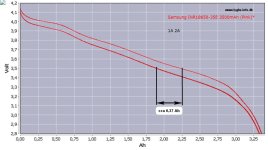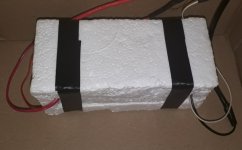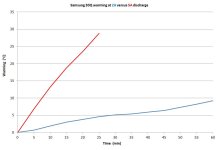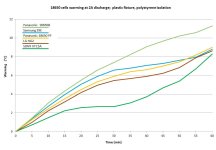Hillhater said:
This data is excellent.
But... I see a real dilema....
In order to ensure a low current per cell, you would have to increase the battery capacity, size ,weight, and cost.
All of those factors are oposite to the fundamental ideal of an Ebike battery,...lightweight, compact, and low cost
Also, thermal dissipation on an ebike is very different to your test conditions, and with a little thought in pack design and configuration, the cell temperatures will be dramatically different in reality.
What you have highlited is the fundamental limitations of the 18650 cell format...a relatively high DCIR compared to some other cells.
You are absolutely right, thermal dissipation on the real battery is very different. And is also different with different battery packs. Even in one battery pack you can measure different temperature through the battery and through the cell itself, depending on the design and configuration. Inner cells can have much higher temperature than cells having contact with the battery shell, even higher than my simulation indicates. And that means temperature inhomogenity through the battery pack and even through the cell. Something undesirable for cells and battery lifetime. Low current per cell has potential to diminish temperature and inhomogenity independent of pack design.
By the way, adversely oriented cells in the triangle design has good probability to have homogenous temperature through the pack.
Battery capacity, weight, size and price is always going to be dilema.
But if new incomer hesitates about such dilema, the message is that bigger capacity always means better. Better lifetime thanks to lower depth of discharge (DOD), lower temperature and better homogenity of the temperature, lower parasitic reactions thanks to lower current per cell. Lower unwanted irreversible chemical reactions that are causing lose capacity and age prematurely. Better range thanks to bigger battery capacity generally and also thanks to higher capacity per cell at lower current.

So investment to as big as possible battery pay-off in the long term. Usually it means not so high increment of total weight, size and money, but can be significant improvement of the range and battery lifetime.
Very important is having properly balanced motor consumption and battery.
Example of unfit combination is 1 kW middle motor BBSHD and 13s4p battery. Such motor can draw from battery 1,5 kW or more. And very often this motor is working with efficiency 50% or lower. You can be sure battery is dead after one or two years for some riders.
For most of ebikers is standard 250 – 350 W motor with peak 500 – 600 W sufficient.
Do you mean that 5p or 6p battery is not lightweight or compact ? And such battery can be suitable for lot of of the standard motors. Often 9p battery can be still acceptable.
Each day milions of e-bikes are in service and majority of them have lightweight and compact battery. And thanks to properly balanced battery capacity to motor consumption the battery lifetime can be sufficient.
I don´t think that relatively high DCIR of 18650 is limitation for ebike. The loss power is calculated as DCIR times second power of the current. So the current is the key.
The problem is often unsuitable chosen and operated, unnecessarily highly kW motor. Style of the ride can also significantly affect battery.






